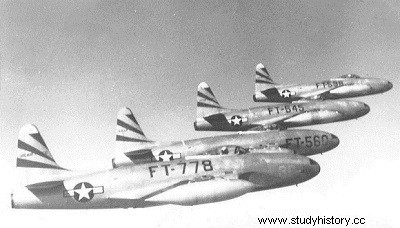
Aircraft:Lockheed F-80C Shooting Star.
Manufacturer:Lockheed Aircraft Corp.
Type:fighter-bomber.
Year:1948.
Engine:General Electric J33-A-
23 turbojet engine with 2,086 kg of thrust.
Wingspan:11, 85 m.
Length:10.51 m.
Height:3.45 m.
Take-off weight:7,646 kg.
Maximum speed:933 km/h at 2,133m altitude.
Maximum operating altitude:13,030 m
Autonomy:2,220 km.
Armament:6 machine guns; 907 kg war load.
Crew:1 person.
Between its conception and its first flight, only 180 days passed! During this short period of time, Lockheed managed to produce an entirely new aircraft, which would become the first operational jet fighter in the United States Air Force. Even if he did not have time to take an active part in the Second World War, the P-80 Shooting Star (we had to wait until 1948 to see the acronym changed to F-80) was used en masse during the Korean conflict:in the During the first four months of employment, these planes accomplished more than 15,000 missions, and on November 8, 1950, one of them took part in the first combat between jets in history. The total number of Shooting Stars built in the three basic versions amounted to 1,715 examples, which remained in front line service until the arrival of the more modern F-84 and F86, but the United States manufactured a quantity more than three times higher (5,691 specimens) of the version of instruction, called T-33 This one became the machine of basic instruction of the USAF and was exported in forty countries. Canada and Japan built another 866 T33s under licence.
The origins of the P-80 project dated back to June 1943, when USAF technicians formally invited Lockheed to produce a single-seat combat aircraft powered by a turbojet engine. At that time, the prototypes of the Bell P-59 Airacomet (the first jet aircraft of American military aviation) had already flown for a long time, but the machine gave unsatisfactory results. The group of Lockheed engineers, led by Clarence L. "Kelly" Johnson, worked out a general design in just one week and asked for six months to manufacture the prototype. He largely respected this program since the first XP-80 flew on January 8, 1944, 139 days after the start of work. The other two requested prototypes (XP-80A) saw the light of day six months later. They differed from the first by the adoption of another engine and structural changes due to the choice of the new propellant. Development work continued on the 13 pre-production units (YP-80A), delivered from October 1944 for operational trials. Among other things, two of these aircraft were sent to Italy immediately after the cessation of hostilities in Europe.
As with other machines designed in wartime, the end of the conflict brought about a sharp reduction in production programs, planned on a very large scale. Lockheed and North American should have built a total of 5,000 copies of the new aircraft; in reality, only Lockheed manufactured the P-80A, of which it produced 917 copies which began to equip the first line detachments of the USAF in December 1945. The last 240 aircraft of this order were presented in the form of the P version -80B, where the modifications were at the level of the engine and the armament. Later equipped with a more powerful propellant, the final model P-80C appeared in 1948 and the number of units built rose to 798. a record flight made on June 19, 1947 by a P-80A, modified for the circumstance, encouraged the development of the P-80C. This machine had a General Electric J33-A-23 engine of 2,086 kilos of thrust (the same that will equip the P-80C series); in addition, both the fuselage and the wings received numerous aerodynamic improvements. These changes enabled Colonel Albert Boyd to break the world average speed record of 1,003.69 kilometers per hour.
When the F-84s and F-86s arrived in the front-line detachments, the Shooting Star was used for secondary duties, especially in units of the Air National Guard. The Americans converted many of these aircraft for photographic reconnaissance and target towing. Production of the instructional version continued until 1959
